Barrie James Matthew
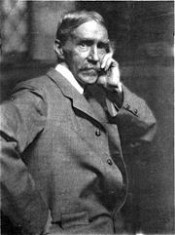
Prendergast was born in St. John's, a city in Newfoundland, Canada. With the failure of his father's subarctic trading post, the family moved to Boston. There, young Maurice was apprenticed to a commercial artist and at the outset was conditioned to the brightly colored, flat patterning effects that characterized his mature work. A shy individual, Maurice remained a bachelor throughout his life. He became closely attached to his artist brother Charles, who was a successful frame maker. For three years, Maurice studied in Paris at the Académie Colarossi and the Académie Julian. During one of his early stays in Paris, he met the Canadian painter James Morrice, who introduced him to English avant-garde artists Walter Sickert and Aubrey Beardsley, all ardent admirers of James McNeill Whistler. The influences of these men set his future painting style. He was a member of the 20th century group of American painters called The Eight, whose members included the group's leader Robert Henri, Everett Shinn, John Sloan, Arthur B. Davies, Ernest Lawson, George Luks, and William Glackens. A further acquaintance with Vuillard and Bonnard placed him firmly in the postimpressionist camp. He developed and continued to elaborate a highly personal style, with boldly contrasting, jewel-like colors, and flattened, patternlike forms rhythmically arranged on a canvas. Forms were radically simplified and presented in flat areas of bright, unmodulated color. His paintings have been aptly described as tapestry-like or resembling mosaics. A trip to Venice in 1898 exposed him to the delightful genre scenes of Vittore Carpaccio and encouraged him toward even more complex and rhythmic arrangements. He also became one of the first Americans to espouse the work of Cézanne and to understand and utilize his expressive use of form and color. Prendergast typically painted people involved in leisurely activities. At the Armory Show in 1913, he displayed seven works that showed his stylistic maturity. Although he predominantly worked in watercolors, he began using oils in his later career. He also produced a large number of monotypes between 1891 and 1902. Green Dress (1891-1894) Street Scene (1891-1894) Lady on the Boulevard/The Green Cape (1892) Along the Seine (1892-94) Skipping Rope (1892-1895) Children at Play (1895) Franklin Park Boston (1895) Spring in Franklin Park (1895) The Tuileries Gardens, Paris (1895) The Breezy Common (1895-1897) Marine Park (1895-1897) South Boston Pier (1895-97) Evening on a Pleasure Boat (1895-1898) Franklin Park Boston (1895-1898) Viewing the Ships (1896) Summer Visitors (1897) Ponte della Paglia (1898-99) Venetian Canal Scene (1898-99) The Balloon (1898) St. Mark's Venice (1898) Easter Procession St. Mark's (1898) Afternoon. Pincian Hill [in Rome], graphite and watercolor by Maurice Prendergast, 1898-9, Honolulu Academy of Arts Courtyard Scene, Siena, watercolor and graphite by Maurice Prendergast, c. 1898-9, Honolulu Academy of Arts The Grand Canal, Venice (1898-1899) Monte Pincio (1898-1899) Monte Pincio Rome (1898-1899) Splash of Sunshine and Rain (1899) Telegraph Hill (1900) West Church Boston (1900-01) Central Park, New York (1901) In Central Park New York (1900-03) Figures Under the Flag (1900-05) The Mall Central Park (1901) May Day Central Park (1901) Madison Square (1901) Opal Sea (1903-1910) Salem Willows (1904) Spring Flowers (1904) Santa Maria Formosa Venice (1911-12) Still Life Apples Vase (1913-1915) Still Life w Apples (1913-1915) The Grove (1915) St. Malo (Unknown) Sunny Day at the Beach (Unknown)
do you like this author?
What readers are saying
What do you think? Write your own comment on this book!
write a commentWhat readers are saying
What do you think? Write your own comment on this author!
write a commentBook list

An Edinburgh ElevenPencil Portraits from College Life
Series:
Unknown
Year:
Unknown
Raiting:
4/5
Show more
add to favoritesadd In favorites
Book list

An Edinburgh ElevenPencil Portraits from College Life
Series:
Unknown
Year:
Unknown
Raiting:
4/5
Show more
add to favoritesadd In favorites

A Window in Thrums
Series:
Unknown
Year:
Unknown
Raiting:
3/5
Purchase of this book includes free trial access to www.million-books.com where you can read more than a million books for free. This is an OCR edition with typos. Excerpt from book: CHAPTER III. PREPARING TO RECEIVE COMPANY. Leeby was at the fire brandering a quarter of steak on the tongs, when the house was flung into consternation by Hendry's casual remark that he had seen Tibbie Mealmaker in the town with her man. " The Lord preserve's !" cried Leeby. Jess looked quickly at the clock. "Halffower!" she said excitedly. " Then it canna be dune," said Leeby, falling despairingly into a chair, " for they may be here ony meenute." " It's most michty," said Jess, turning on her husband, " 'at ye should tak a pleasure in bringin' this hoose to disgrace. Hoo did ye no tell's suner?" " I fair forgot," Hendry answered, " but what's a' yer steer ?" Jess looked at me (she often did this) in a way that meant, " What a man is this I'm tied to!" "Steer!" she exclaimed. " Is't no time we was makkin' a steer ? They'll be in for their tea ony meenute, an' the room no sae muckle as sweepit . Ay, an' me lookin' like a sweep ; an' Tibbie Mealmakcr 'at's sae partikler genteel seein' you sic a sicht as ye are!" Jess shook Hendry out of his chair, while Leeby began to sweep with the one hand, and agitatedly to unbutton her wrapper with the other. " She didna see me," said Hendry, sitting down forlornly on the table. Get aff that table!" cried Jess. " See haud o' the besom," she said to Leeby. " For mercy's sake, mother," said Leeby, " gie yer face a dicht, an' put on a clean mutch." " I'll open the door if they come afore you're ready," said Hendry, as Leeby pushed him against the dresser. " Ye daur to speak aboot openin' the door, an'you sic a mess!" cried Jess, with pins in her mouth. " Havers!" retorted Hendry. " A man canna be aye washin' at 'imsel." Seeing that Hendry was as much in the way as myself, I invited him upstai...
Show more
add to favoritesadd In favorites
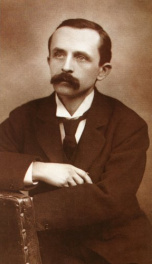
What Every Woman Knows
Series:
Unknown
Year:
Unknown
Raiting:
2/5
The British dramatist and novelist Sir James Matthew Barrie (1860-1937), best known for his play “Peter Pan”. His plays, “What Every Woman Knows” being one of the Barrie’s most realistic, played an important role in the revival of the English theatre of the early twentieth century. This work, full of humor and irony, reveals a well known theme that behind every man there is a woman who makes him either a success or a failure.
Show more
add to favoritesadd In favorites

Tommy and Grizel
Series:
Unknown
Year:
Unknown
Raiting:
2.5/5
Purchase of this book includes free trial access to www.million-books.com where you can read more than a million books for free. This is an OCR edition with typos. Excerpt from book: been " Bits Cut out of a Story because they Prevented its Marching." If you have any memory you do not need to be told how that splendid study, so ennobling, so penetrating, of woman at her best, took the town. Tommy woke a famous man, and except Elspeth no one was more pleased than big-hearted, hopeless bleary Pym. " But how the has it all come about 1" he kept roaring. " A woman can be anything that the man who loves her would have her be," says the " Letters," and " Oh," said woman everywhere, " if all men had the same idea of us as Mr. Sandys!" " To meet Mr. T. Sandys." Leaders of society wrote it on their invitation cards. Their daughters a-thirst for a new sensation thrilled at the thought, "Will he talk to us as nobly as he writes! " and oh, how willing he was to do it, especially if their noses were slightly tilted. chapter{Section 4CHAPTER HI SANDYS OK WOMAX M Can you kindly tell me the name of the book I want ? " It is the commonest question asked at the circulating library by dainty ladies just out of the carriage, and the librarian after looking them over can usually tell. In the days we have now to speak of, however, he answered, without looking them over: "Sandys's Letters." "Ah, yes, of course. May I have it, please ? " "I regret to find that it is out." Then the lady looked naughty. "Why don't you have two copies ? " she pouted. "Madam," said the librarian, "we have a thousand." A small and very timid girl of eighteen, with a neat figure that shrank from observation, although it was already aware that it looked best in gray, was there to drink in this music and carried it home in her heart. She was Elspeth, and that dear heart was almost too full at this time; I hesitate whether to tell or to conceal how it even created a disturbance i...
Show more
add to favoritesadd In favorites

Sentimental Tommy
Series:
Unknown
Year:
Unknown
Raiting:
2.5/5
A psychological novel by Scottish author and dramatist, the creator of Peter Pan, Sir James Matthew Barrie, follows the life of a poor Scottish boy with an endless imagination, since the age of 5, his growing up and surroundings. Later the novel was followed by "Tommy and Grizel” (1900).
Show more
add to favoritesadd In favorites
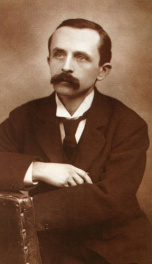
Peter Pan in Kensington Gardens
Series:
Unknown
Year:
Unknown
Raiting:
4/5
One of four major literary works by J. M. Barrie, a Scottish author and dramatis. In spite of the fact that the book was written after the well known “Peter Pan”, it narrates of the events, which precede Peter and Wendy’s acquaintance. The story takes place in Kensington Gardens, a famous park in London, where little Peter, a seven-day-old infant escapes from his cradle.
Show more
add to favoritesadd In favorites

Peter and Wendy
Series:
Unknown
Year:
Unknown
Raiting:
1/5
Sir James Matthew Barrie, 1st Baronet, OM (1860- 1937), more commonly known as J. M. Barrie, was a Scottish novelist and dramatist. He is best known for inventing the character of Peter Pan, whom he based on his friends, the Llewelyn Davies boys. Barrie’s first novels were set in Kirriemuir, Scotland, which he referred to as “Thrums” (his father worked as a weaver). His Thrums novels were hugely successful when they were published, including Auld Licht Idylls (1888) and The Little Minister (1891). His two ‘Tommy’ novels, Sentimental Tommy (1896) and Tommy and Grizel (1902), dealt with themes much more explicitly related to what would become Peter Pan. The first appearance of Pan came in The Little White Bird (1901), followed by a play, and then the classic, Peter and Wendy (1911), later retitled Peter Pan. He also wrote for the theatre, his plays including Quality Street (1901), What Every Woman Knows (1908) and The Admirable Crichton (1902). --This text refers to an alternate Paperback edition.
Show more
add to favoritesadd In favorites
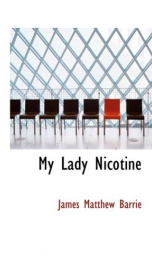
My Lady Nicotine
Series:
Unknown
Year:
Unknown
Raiting:
2.5/5
This ingenious story begins from the end: counting the round sums spent on evil passion, the narrator gives convincing proofs that one should not, under any pretence, smoke; all the more his fiancée has unequivocally declared – either her or tobacco. So, he gave up smoking; and the rest of the book is an account, a canto, even hymn for smoking, bringing so much trouble, making you forget everything, except the only pleasure in this world. The hero is longing for the old times, dreaming of friends-smokers and the adventures of his bachelor life. He cherishes in memory his pipes, the beloved tobacco Craven mixture, he calls Arcadia, imagines Shakespeare fist smoking experience, his friends trying to convince his bride that giving up could be very harmful…
This story that still appears to be a peculiar “bible of pipe-smokers”, introduces us a famous Scottish author and dramatist, the creator of Peter Pan, Sir James Matthew Barrie, as a humorist.
Show more
add to favoritesadd In favorites
This story that still appears to be a peculiar “bible of pipe-smokers”, introduces us a famous Scottish author and dramatist, the creator of Peter Pan, Sir James Matthew Barrie, as a humorist.
Show more

Margaret Ogilvy
Series:
Unknown
Year:
Unknown
Raiting:
2/5
Purchase of this book includes free trial access to www.million-books.com where you can read more than a million books for free. This is an OCR edition with typos. Excerpt from book: CHAPTER III WHAT I SHOULD BE My mother was a great reader, and with ten minutes to spare before the starch was ready would begin the ' Decline and Fall' and finish it, too, that winter. Foreign words in the text annoyed her and made her bemoan her want of a classical education she had only attended a Dame's school during some easy months but she never passed the foreign words by until their meaning was explained to her, and when next she and they met it was as acquaintances, which I think was clever of her. One of her delights was to learn from me scraps of Horace, and then bring them into her conversation with c colleged men.' I have come upon her in lonely places, such as the stair-head or the east room, muttering these quotations aloud to herself, and I well remember how she would say to the visitors, ' Ay, ay, it's very true, Doctor, but as you know, " Eheu fugaces, Postume, Postume, labuntur anni," ' or ' Sal, Mr. so and so, my lassie is thriving well, but would it no be more to the point to say " O mater, pulchra filia pulchrior " ?' which astounded them very much if she managed to reach the end without being flung, but usually she had a fit of laughing in the middle, and so they found her out. Biography and exploration were her favourite reading, for choice the biography of men who had been good to their mothers, and she liked the explorers to be alive so that she could shudder at the thought of their venturing forth again, but though she expressed a hope that they would have the sense to stay at home henceforth, she gleamed with admiration when they disappointed her. In later days I had a friend who was an African explorer, and she was in two minds about him ; he was one of the most engrossing of mortals to her, she admired him prodigiously, pictur... --This text refers to an alternate Paperback edition.
Show more
add to favoritesadd In favorites
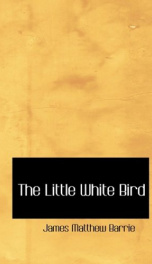
The Little White Bird; or, Adventures in Kensington gardens
Series:
Unknown
Year:
Unknown
Raiting:
1.5/5
A 1902 novel by a Scottish author and dramatist Sir James Matthew Barrie. The book tells a story of a very shy man, lonely and not young. The girl in whom he was in love has married another man; and the lonely bachelor helps to bring up their only son, David. Taking a walk along the Kensington gardens, he tells his the stories of wonderful people, brave girl, and an amazing boy Peter Pan. A beautiful book – both sad and joyful story.
Show more
add to favoritesadd In favorites

Echoes of the War
Series:
Unknown
Year:
Unknown
Raiting:
1/5
This book was converted from its physical edition to the digital format by a community of volunteers. You may find it for free on the web. Purchase of the Kindle edition includes wireless delivery.
Show more
add to favoritesadd In favorites
What readers are saying
What do you think? Write your own comment on this author!
write a commentGenre
- Books / Great Britain / History / Henry VI, 1422-1461
- Nonfiction / Politics / General
- Literature & Fiction / Classics
- Religion & Spirituality / Christianity / Literature & Fiction / Fiction
- Nonfiction / Education
- Religion & Spirituality / Christianity / Church History
- Religion & Spirituality / Christianity / Reference / New Testament
- Nonfiction / Education / Education Theory / History
- Reference / Atlases & Maps / World
if you like Barrie James Matthew try:
readers also enjoyed
What readers are saying
What do you think? Write your own comment on this author!
write a commentGenre
- Books / Great Britain / History / Henry VI, 1422-1461
- Nonfiction / Politics / General
- Literature & Fiction / Classics
- Religion & Spirituality / Christianity / Literature & Fiction / Fiction
- Nonfiction / Education
- Religion & Spirituality / Christianity / Church History
- Religion & Spirituality / Christianity / Reference / New Testament
- Nonfiction / Education / Education Theory / History
- Reference / Atlases & Maps / World
if you like Barrie James Matthew try:
readers also enjoyed
Do you want to read a book that interests you? It’s EASY!
Create an account and send a request for reading to other users on the Webpage of the book!

